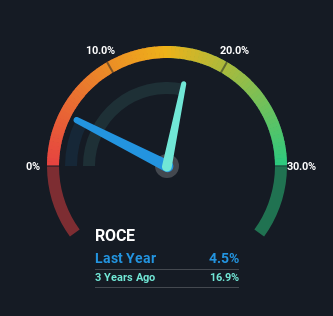
What trends should we look for it we want to identify stocks that can multiply in value over the long term? Firstly, we'll want to see a proven return on capital employed (ROCE) that is increasing, and secondly, an expanding base of capital employed. Ultimately, this demonstrates that it's a business that is reinvesting profits at increasing rates of return. Although, when we looked at Balticon (WSE:BLT), it didn't seem to tick all of these boxes.
Return On Capital Employed (ROCE): What Is It?
For those that aren't sure what ROCE is, it measures the amount of pre-tax profits a company can generate from the capital employed in its business. The formula for this calculation on Balticon is:
Return on Capital Employed = Earnings Before Interest and Tax (EBIT) ÷ (Total Assets - Current Liabilities)
0.045 = zł3.7m ÷ (zł133m - zł51m) (Based on the trailing twelve months to December 2023).
Therefore, Balticon has an ROCE of 4.5%. In absolute terms, that's a low return and it also under-performs the Commercial Services industry average of 13%.
Check out our latest analysis for Balticon

Historical performance is a great place to start when researching a stock so above you can see the gauge for Balticon's ROCE against it's prior returns. If you'd like to look at how Balticon has performed in the past in other metrics, you can view this free graph of Balticon's past earnings, revenue and cash flow.
So How Is Balticon's ROCE Trending?
On the surface, the trend of ROCE at Balticon doesn't inspire confidence. To be more specific, ROCE has fallen from 7.2% over the last five years. On the other hand, the company has been employing more capital without a corresponding improvement in sales in the last year, which could suggest these investments are longer term plays. It's worth keeping an eye on the company's earnings from here on to see if these investments do end up contributing to the bottom line.
The Bottom Line
In summary, Balticon is reinvesting funds back into the business for growth but unfortunately it looks like sales haven't increased much just yet. And investors may be recognizing these trends since the stock has only returned a total of 5.6% to shareholders over the last five years. Therefore, if you're looking for a multi-bagger, we'd propose looking at other options.
One final note, you should learn about the 4 warning signs we've spotted with Balticon (including 1 which is a bit concerning) .
While Balticon may not currently earn the highest returns, we've compiled a list of companies that currently earn more than 25% return on equity. Check out this free list here.
Valuation is complex, but we're here to simplify it.
Discover if Balticon might be undervalued or overvalued with our detailed analysis, featuring fair value estimates, potential risks, dividends, insider trades, and its financial condition.
Access Free AnalysisHave feedback on this article? Concerned about the content? Get in touch with us directly. Alternatively, email editorial-team (at) simplywallst.com.
This article by Simply Wall St is general in nature. We provide commentary based on historical data and analyst forecasts only using an unbiased methodology and our articles are not intended to be financial advice. It does not constitute a recommendation to buy or sell any stock, and does not take account of your objectives, or your financial situation. We aim to bring you long-term focused analysis driven by fundamental data. Note that our analysis may not factor in the latest price-sensitive company announcements or qualitative material. Simply Wall St has no position in any stocks mentioned.
About WSE:BLT
Flawless balance sheet with proven track record.
Market Insights
Community Narratives



